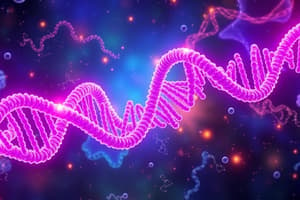Podcast
Questions and Answers
What does the RNA World Hypothesis propose about early life forms?
What does the RNA World Hypothesis propose about early life forms?
It proposes that early life used RNA, not DNA, for genetic information and catalysis.
Identify the components that make up RNA.
Identify the components that make up RNA.
RNA is made up of nucleotides, which consist of ribose sugars, nitrogenous bases, and phosphate groups.
List the nitrogenous bases found in RNA.
List the nitrogenous bases found in RNA.
The nitrogenous bases in RNA are adenine, guanine, uracil, and cytosine.
How does RNA participate in living organisms and viruses?
How does RNA participate in living organisms and viruses?
Contrast RNA with DNA in terms of their roles in early life according to the RNA World Hypothesis.
Contrast RNA with DNA in terms of their roles in early life according to the RNA World Hypothesis.
What is a notable nutrient comparison between moringa leaves and oranges?
What is a notable nutrient comparison between moringa leaves and oranges?
How much more vitamin A do moringa leaves contain compared to carrots?
How much more vitamin A do moringa leaves contain compared to carrots?
In terms of calcium, how do moringa leaves compare to milk?
In terms of calcium, how do moringa leaves compare to milk?
What is the potassium content of moringa leaves compared to bananas?
What is the potassium content of moringa leaves compared to bananas?
How does the protein content of moringa leaves compare to yogurt?
How does the protein content of moringa leaves compare to yogurt?
Flashcards are hidden until you start studying
Study Notes
RNA World Hypothesis
- Proposes that the earliest forms of life utilized RNA instead of DNA for both storing genetic information and facilitating chemical reactions.
- Suggests that RNA played a dual role in early biochemical processes, serving both as a genetic material and as a catalyst.
Structure of RNA
- Composed of nucleotides, which are essential building blocks.
- Each nucleotide consists of:
- A ribose sugar
- A nitrogenous base
- A phosphate group
Nitrogenous Bases in RNA
- Four main nitrogenous bases are present in RNA:
- Adenine (A)
- Guanine (G)
- Uracil (U)
- Cytosine (C)
- Uracil replaces thymine, which is found in DNA.
Presence and Significance
- RNA is found in all living organisms and many viruses, indicating its fundamental role in cellular processes.
- Central to various biological functions, including protein synthesis and regulation of gene expression.
Nutritional Benefits of Moringa Leaves
- Moringa leaves are nutrient-dense and offer a wide array of health benefits.
- These leaves contain seven times more vitamin C than oranges, supporting immune function and skin health.
- Moringa offers four times the vitamin A found in carrots, promoting good vision and immune health.
- Calcium content in moringa is four times that of milk, essential for strong bones and teeth.
- Moringa leaves provide three times the potassium of bananas, important for heart health and regulating blood pressure.
- They contain double the protein of yogurt, aiding in muscle repair and overall growth.
Studying That Suits You
Use AI to generate personalized quizzes and flashcards to suit your learning preferences.




